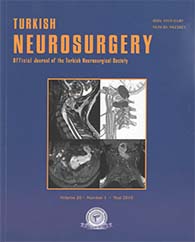2Departments of Intensive Care & Neurosurgery GB Pant Hospital, New Delhi, INDIA AIM: Despite being a minimally invasive procedure, serious perioperative complications are reported during neuroendoscopy, largely generated by its unique surgical maneuvers. We report here the complications of elective neuroendoscopic surgery for the treatment of hydrocephalus and other intraventricular pathology in 298 patients over a 7-year period at our institute.
MATERIAL and METHODS: The complication rate was determined by recording intraoperative hemodynamic variables, core temperature, bleeding episodes, time to arouse from anesthesia, serum electrolytes and neurological deterioration in the immediate postoperative period.
RESULTS: Intraoperative complications included hemodynamic alterations in the form of tachycardia (57 patients, 20.1%), bradycardia (35 patients, 12.4%) and hypertension. Bleeding episodes were major in 4 patients (1.4%) and minor in 32 patients (11.3%). Hypothermia occurred in 12 patients (4.2 %), delayed awakening in 3 patients (1.1%) and electrolyte imbalance in 3 patients (1.1%). Postoperatively, 2 patients each had convulsions, anisocoria and evidence of 3rd cranial nerve injury. Mortality from observed complications was 1.1% (3 patients).
CONCLUSION: Complications during neuroendoscopy may adversely affect its perioperative outcome. Anticipation of these complications in relation to the different surgical maneuvers, their prompt detection by close perioperative monitoring and coordinated efforts of the anesthetist and surgeon in treating them can help minimise the risks associated with neuroendoscopic procedures.
Keywords : Neuroendoscopy, Endoscopic third ventriculostomy, Minimally invasive neurosurgery, Intraventricular endoscopic neurosurgery




